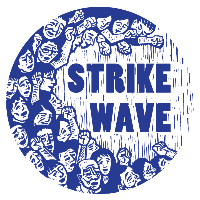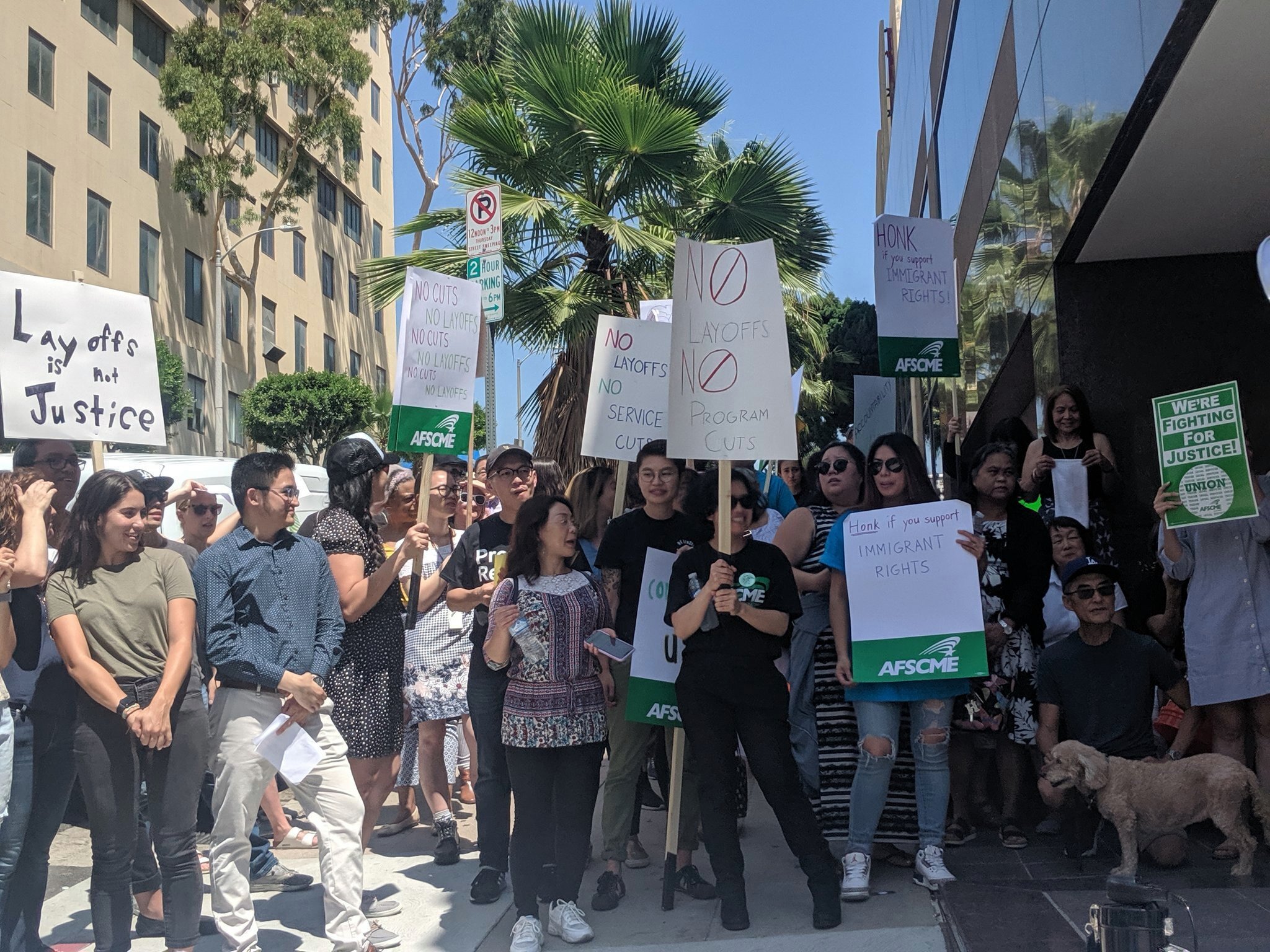A Rising Tide: Inside the Union Organizing Wave Taking Over Los Angeles Nonprofits
by Max Belasco
When asked about his reasons for organizing his workplace, Agustin Herrera takes a moment to respond. He and his colleagues work at Asian Americans Advancing Justice (AAAJ), a major civil rights organization operating in Los Angeles. Herrera rattles off a list of familiar grievances with management—job security in an increasingly unaffordable Los Angeles, accountability to the staff, fixing the disparity of pay between staff and executive management. He does not finish his list, however, without remarking almost as an afterthought, “the workplace shouldn’t catch on fire.”
In 2016, AAAJ moved its Youth and Parent Development department to a new location. Herrera, a Youth and Parent Advocate, was among the staff moved. Soon after the relocation, a fire broke out in the new office, and Herrera and his colleagues realized the building lacked safe evacuation routes. They were forced to break windows in order to escape. The incident was followed by the air conditioner breaking down in the middle of summer in 2017. Management instructed staff to “tough it out” until repairs could be made.
At this point it was clear to Herrera and his coworkers that their issues would only be resolved if they worked together. Conversations about unionizing began. By March of 2018, AAAJ voluntarily recognized their staff’s union, which organized with the American Federation of State, County, and Municipal Employees (AFSCME).
Organizing as fire repellant
While Herrera’s nonprofit organizing story is unique, it is certainly not the only one. The union drive at AAAJ is part of a wave of nonprofit organizing campaigns across Los Angeles. While organizations have unionized in the city before—including the legal nonprofit Bet Tzedek—the sheer number of prominent public campaigns currently happening across the city suggests a sea change in the climate of nonprofit work in Los Angeles. Workers see flexing their collective power as critical to fulfilling their organization’s mission.
“My organization means a lot to me,” according to Roberto Saravia, a Development Associate for the Central American Resource Center (CARECEN). “But it does not bode well for an organization to be treating your workers this way, pushing out valuable and experienced staff before and during campaigns.” Founded in 1983 to provide support to Central Americans resettling in Los Angeles after fleeing civil war in their home countries, CARECEN is a fixture in the local progressive scene, and sits at the intersection of immigrant rights and the labor movement. In addition to providing immigration services, CARECEN also houses a worker center that organizes day laborers and contract workers. Overworking staff and case workers has been and ongoing issue at the nonprofit, and Saravia, along with staff at other CARECEN offices across Los Angeles, were able to successfully organize a union with the International Association of Machinists and Aerospace Workers (IAMAW) in the summer of 2018. An overwhelming 88% of the staff voted for the union.
Evelyn Martinez, a staff attorney in CARECEN’s San Fernando Valley office, notes that while she and Saravia were not part of the initial organizing committee they were fully supportive once they became aware of the union drive. “Most staff attorneys have been here for less than three years—that’s a high attrition rate, and burnout is a real thing.” Martinez is deeply committed to ensuring that she and her coworkers can keep up with the legal needs of the community they serve, since they have increased with the anti-immigrant fervor the Trump administration has fomented. “To keep up with the needs of families seeking refuge you end up putting a lot of the work on legal assistants, and they’re just not being properly compensated for how emotionally, mentally draining this work can be.”
Legal assistants often need to assist staff attorneys who are helping clients navigate the bureaucracy of United States immigration policy, and tensions are always high. “I don’t think anyone who hasn’t done this work,” Martinez says, “can understand how draining it can be to sit with a client who is crying, worried that missing a filing deadline is going to tear her away from her family, and how the outcome of that can stay with you for a long while.” Similarly, Saravia notes that poor working conditions have led to high turnover among CARECEN’s staff. “Cases get turned over regularly, and can get dropped for up to six months. If we have well-trained staff, staff that’s happy, staff that’s able to manage their caseload, we’ll have a better relationship with the community.”
Herrera agrees that organizers are overworked at AAAJ, but also attributes dissatisfaction to the nature of the work being foisted on community organizers, advocates, and other staff. “The heart of our organization is a legal center, and that leads to us taking on a lot of legislative campaigns and pushing forward bills,” he explains. “But that can sometimes be at odds with what the community needs, right now.” While the local Asian American community may be more responsive to local vigils commemorating murdered community members like mail carrier Joseph Ileto, community basebuilding can take a back seat to legislative priorities set by AAAJ’s executive board. “If the community wants more citizenship classes in their hood, organizers should be pushing to do that first and foremost. We’re the most attuned to what the community wants, and [that’s] why we need a seat at the table.”
Worker-led priorities, fulfilling community needs
This contradiction in priorities is at the heart of what Herrera and others identify as the Nonprofit Industrial Complex: the system through which progressive politics (as articulated by nonprofits) becomes diluted due to reliance on donors that demand their money be used in specific ways, and for specific ends. Beyond ensuring working air conditioners and an end to workplace fires, Herrera and his coworkers view influencing the trajectory of AAAJ’s work as a critical objective of their union.
Saravia recognizes the problems presented by the Nonprofit Industrial Complex as well, and notes (as one of the workers focused on fundraising at CARECEN), “grants all come with deliverables, and so much of the funding comes with strings attached.” Allowing donors and grants to dictate the terms by which funding is provided inherently limits the nonprofit in the services it can provide. Nonprofit organizers are left out of the decision making, despite being the most knowledgeable about the needs of the communities their nonprofit serves.
“With a union you have institutional memory of what has happened,” says HyunJoo Lee of Public Counsel, a public interest law firm that provides free legal and social services to marginalized communities in Los Angeles. “Our firm is huge—we have so many projects and so many folks—and the union is where we can come together.” Staff at Public Counsel began to organize in January 2019, inspired in part by the successful unionizing campaigns at CARECEN and AAAJ.
The union drive at Public Counsel was difficult. Management had recently raised staff minimum wages and made changes to the work culture that employees had been demanding. With these changes fresh in everyone’s mind, the organizing committee had difficulty making the case for why a union was necessary. Lee points out, however, that these changes were enacted in response to staff airing out issues with management, and that a union will ensure these welcomed changes become permanent. “We’re protecting the parts of the culture that we like. We wanted our core value—access to justice—to be put into practice in our workplace. Now we have that, and we have a way of remembering how we won that.” That those concessions from management had to be fought for, and were not freely given away, is something Lee hopes the union can help new staff understand when they arrive.
Tides of social change
Not every nonprofit union drive has been successful. A union filing in June 2019 at Strategic Concepts in Organizing and Policy Education (SCOPE), a community-based organization in South LA, was followed shortly after by mass resignations in the staff . Staff at AAAJ have also experienced massive rounds of layoffs, with upper management demanding that workers bear the brunt of budget cuts.
Still, AAAJ staff are fighting back. They, and other nonprofit workers involved in organizing drives throughout Los Angeles—including CARECEN and Public Counsel—are demanding not just fair compensation, but changes to organizational function that will lead to healthier, more efficient vehicles for change. “When we talk about social justice,” says Lee, “it needs to be mirrored in every room.” This wave of nonprofit organizing is bringing a new understanding of social change with it—that in order to make a Los Angeles for working people, the workers directly engaged in that project should have a voice as well. The nonprofit workers of Los Angeles are showing the world that the best way to put out an office fire is through mutual solidarity.
Max Belasco is a rank-and-file member of UPTE-CWA and a member of the Strikewave Editorial Collective.
Note: A previous version of this article referred to layoffs at SCOPE. It has been updated to reflect that the filing was followed by mass resignations.

